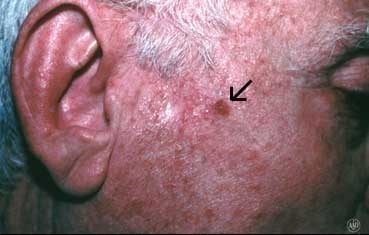Skin Cancer Diagnosis And Treatment in North Adams
Melanoma

Melanoma is the most serious type of skin cancer. Allowed to grow, melanoma can spread quickly to other parts of the body. This can be deadly.
There is good news. When found early, melanoma is highly treatable.
You can find melanoma early by following this 3-step process:
- Learn the warning signs of melanoma.
- Look for the warning signs while examining your skin.
- See a dermatologist if you find any of the warning signs.
It only takes a few minutes to learn the warning signs. You’ll find everything you need to start examining your skin today on the Body Mole Map.
Squamous Cell Carcinoma

Squamous cell carcinoma is the second most common type of skin cancer and affects 100,000 Americans every year. The cancer mostly appears in areas most often exposed to the sun but can appear anywhere on the body. If left untreated, the cancer can break through to the tissue underneath the skin’s surface and spread to other tissues and organs. This type of cancer is generally caused by overexposure to the sun and can sometimes occur in areas that had been previously injured or exposed to chemicals or X-rays. Fair-skinned people are more likely to develop squamous cell carcinoma than darker-skinned individuals. The condition can be identified as thickened, scaly lesions in the affected area and may sometimes resemble warts or open sores. There are several treatment options, including excisional surgery, radiation and laser surgery. When diagnosed early, squamous cell carcinoma is almost always curable.
Basal Cell Carcinoma

The most common type of skin cancer is basal cell carcinoma. This type of cancer can affect 800,000 people in America every year. Overexposure to the sun is the common culprit behind basal cell carcinoma and is predominantly found in areas such as the face, neck and ears, Fair-skinned individuals and those without outdoor occupations are more at risk of developing this type of cancer. Basal cell carcinoma can present itself in a variety of fashions, such as an open sore, reddish patch or pink growth. Self-examination is vital for early diagnosis and should occur once a month for those at a higher risk. A biopsy on the suspected area can confirm the diagnosis, and there are several methods of treatment. Many factors, such as type, size and location, will determine the best course of treatment. Options may include excisional surgery, electrosurgery, cryosurgery or radiation therapy.
Request Your Consultation
Once you’ve have found the treatment that you would like to receive or need to have a more specific advice, we welcome you to visit us to discuss your cosmetic goals. Ready to get started right now? Please request your consultation by submitting the form below.



